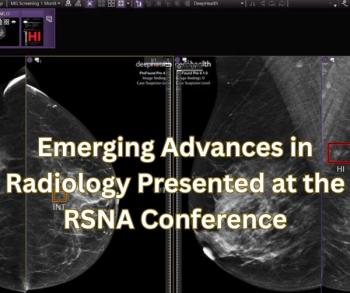
Storage area networks address data overload problems in PACS
Modern radiology is on the verge of creating a storage problem of mammoth proportions. Multislice CT, real-time MRI, 3-D ultrasound, and digital cardiac cath generate massive volumes of data that will be all but impossible to absorb with conventional
Modern radiology is on the verge of creating a storage problem of mammoth proportions. Multislice CT, real-time MRI, 3-D ultrasound, and digital cardiac cath generate massive volumes of data that will be all but impossible to absorb with conventional PACS. Storage area networks may be the answer.
SANs provide nearly instant access to a virtually unlimited storage pool. They allow the storage of primary data as well as backup data and can be tied into existing local, metropolitan, and wide area networks. The benefits are data availability, performance, scalability to need, and reduced management costs.
The flexibility and general utility of these networks make them readily applicable to medical uses, as imaging applications can be piggybacked on administrative duties required by hospitals. These may include such mundane tasks as database management and payroll.
“SANs excel at applications that involve a lot of data where the data are needed fast and have to be available 24/7,” said Spencer Sells, product marketing manager at Gadzoox Networks. “That’s where medical applications are interesting, especially with a PACS, because you need to make sure that doctors can get the images when they are needed.”
Gadzoox Networks is a premier provider of SAN hardware and software. Sold through OEMs including Hewlett-Packard, Compaq, and Data General, as well as through system integrators and other distributors, Gadzoox technologies use fiber channels to transmit data at up to 2 Gb per secondÑeasily enough to handle anything from chest radiographs (10 MB) to comprehensive MR angiograms (400 MB) in a matter of seconds.
Among the companies competing with Gadzoox in this market is Brocade Communications, which provides the networking foundation for SANs, particularly fabric switches and software. Like Gadzoox, Brocade sells its products through OEM partners, system integrators, and resellers. Other competitors include McData and Vixel, two companies focused, like Gadzoox, on the infrastructure of SANs.
These technologies are built into special-purpose subnetworks that interconnect data storage devices and data servers. They are usually clustered close to other computing resources, such as mainframe computers. Recent developments in fiber optics, however, have vastly extended the range of these subnetworks. Sells noted that asynchronous transfer mode or synchronous optical networks can connect these clusters as far as 10 kilometers from the central site, providing flexibility to system developers when establishing remote locations for backup and archival data storage.
“You could run this 2-Gb pipe from your CT room to storage systems somewhere in the basement or to hospitals up to 10 kilometers away, so you could have two or more hospitals working together with a data center supporting them,” Sells said.
These networks are not specific to any one industry, according to Sells. Rather they are being implemented in many areas, including government, education, manufacturing, e-commerce, and medicine. The ubiquity and flexibility of the networks could be a major advantage for medical imaging because SANs could be installed over existing local or wide area networks for a variety of purposes.
In medical imaging, such high-speed networking promises to reduce file retrieval time from minutes or hours on a conventional PACS to just seconds. Additionally, by pooling devices on a SAN, any device on the network can be allocated as much or as little storage as needed. The danger of a network crash due to natural disaster, planned maintenance, or human error is reduced through safeguards such as fault tolerance, mirroring, and clustering. The loss of one or even several servers would not necessarily prevent the retrieval of data, Sells said, because multiple servers are attached to the data storage using fiber channels.
The implementation of SANs could move forward rapidly, according to Sells. Advanced technologies are being developed that vastly increase the speed of transmission. Increasing the appeal further are falling prices for servers and communications technology and the development of standards that allow different types of technologies to work with each other. These are coming from such groups as the Internet Engineering Task Force, the American National Standards Institute, and the Storage Networking Industry Association.
“SAN technology is poised to take off in medical imaging now that we have lower price points and better interoperability,” Sells said. “It’s just a matter of getting the right people together who know the medical imaging field and its particular needs.”
Newsletter
Stay at the forefront of radiology with the Diagnostic Imaging newsletter, delivering the latest news, clinical insights, and imaging advancements for today’s radiologists.




























